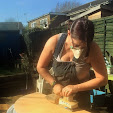At the Learning Technologies conference at the end of January, Itiel Dror took it one step further, and told us that we needed to concern ourselves with the brain. He used a real live brain-in-a-bottle to make his point. Okay - it wasn't live, but it was real (oh, and that isn't Itiel in the picture, by the way, it's the chairman of Learning Technologies, Don Taylor).
He told us in no uncertain terms that, without an understanding of how the brain works, we can't possibly provide effective learning experiences, and he used a few party trick type exercises to demonstrate this assertion. I couldn't help wondering how that would go over with the people who had told me they didn't even need to know the theory behind learning to provide effective learning experiences!
The conversation around a recent post from Harold Jarche reminded me of some research I had done towards yet another paper, in which I had encountered the work of people like Gemma Calvert, Mairead MacSweeney and John Geake. These people tell us (and appear to have the quantitative data to back it up):
- blind people map their environment using the same parts of the brain as sighted people
- sign language is processed using the same brain processes as verbal speech (I'm not sure if this applies only to deaf people or to second-modality signers as well)
- none of us is left- or right-brained. In fact, excluding abnormalities, we are all whole-brained - we need various bits of the brain to work in concert to complete just about any task. It seems that competency is more a product of this connectedness than any other factor. So the more connections there are between the bits of your brain engaged in a task, and the more quickly they interact, the more competently you will complete the task.
- there seems to be some disagreement as to whether specific areas of the brain can be associated with specific functions. Some say no - that every function is the result of mulitple areas working together, and have the MRI images to prove it. Others say yes and cite cases of selective brain damage to prove this.
Itiel Dror also touched on the subject of multitasking. His assertion was that, if two tasks can be completed using different brain functions, in other words, they do not complete with one another for brian resources, they can be successfully completed simultaneously. However, if two tasks make demands on the same areas of the brain, attempting to complete them simultaneously will result in both being poorly executed.
The age-old stereotype is that woman can, men can't. I would argue that the more traditional female role required her to multitask and she became practised at it. It certainly seems that they are not genetically predisposed to superior skill in this area. Perhaps the tasks that women have traditionally carried out simultaneously have not competed for brain resources - maybe cooking the dinner and helping Johnny with his homework, or ironing and watching television require the engagement of two different areas of the brain. Perhaps, on the other hand, those that men have tried to complete simultaneously have made demands on the same brain functions.
Recently, a BBC Radio 4 programme explored this concept, citing research that indicated that women were in fact no better than men at multitasking. I wonder if this has anything to do with the move away from traditional homemaker roles into increased emphasis on cerebral engagement on multiple fronts.
It's fascinating stuff. Or at least I think so.
I wonder if this anorak comes in other colours.


2 comments:
Karyn,
I've been reading silently for months, and want to comment. I must be a total Anorak, because I find learning and brain theory fascinating.
I am a Sales Trainer in Canada, and I simply could not be anywhere near as effective as I am now (according to all reports) if I didn't know when to blend Gagne's 9 instructional events with Social Constructivist activities.
I like what you say about nobody being "right or left brained" because everyone is truly both.
I think an argument can be made however for which hemisphere you feel more comfortable in - I like to say I hang out alot in my right hemisphere - the visual, creative, somewhat random part of my brain.
The ironic thing is, that most of my creativity comes out in the form of language and silly songs and rhymes, which most people tell us live on the left half.
So maybe I'm contradicting myself entirely.
Keep up the great Blog. I love it and have referred it to everyone in our Global Training Department of my company.
Jason
Thanks for your comment, Jason, and happy to have you as a reader.
With regard to your observation about the creative and logical hemispheres of the brain - it is precisely this that John Geake says is not the case. His MRI work has demonstrated cross hemispherical activity equally engaging both halves in both creative and logical tasks.
And by the way, I am delighted to know that I am not the only silly songster on the planet. I have made up rhymes and songs all my life - my kids tell me I'm totally "random".
Post a Comment